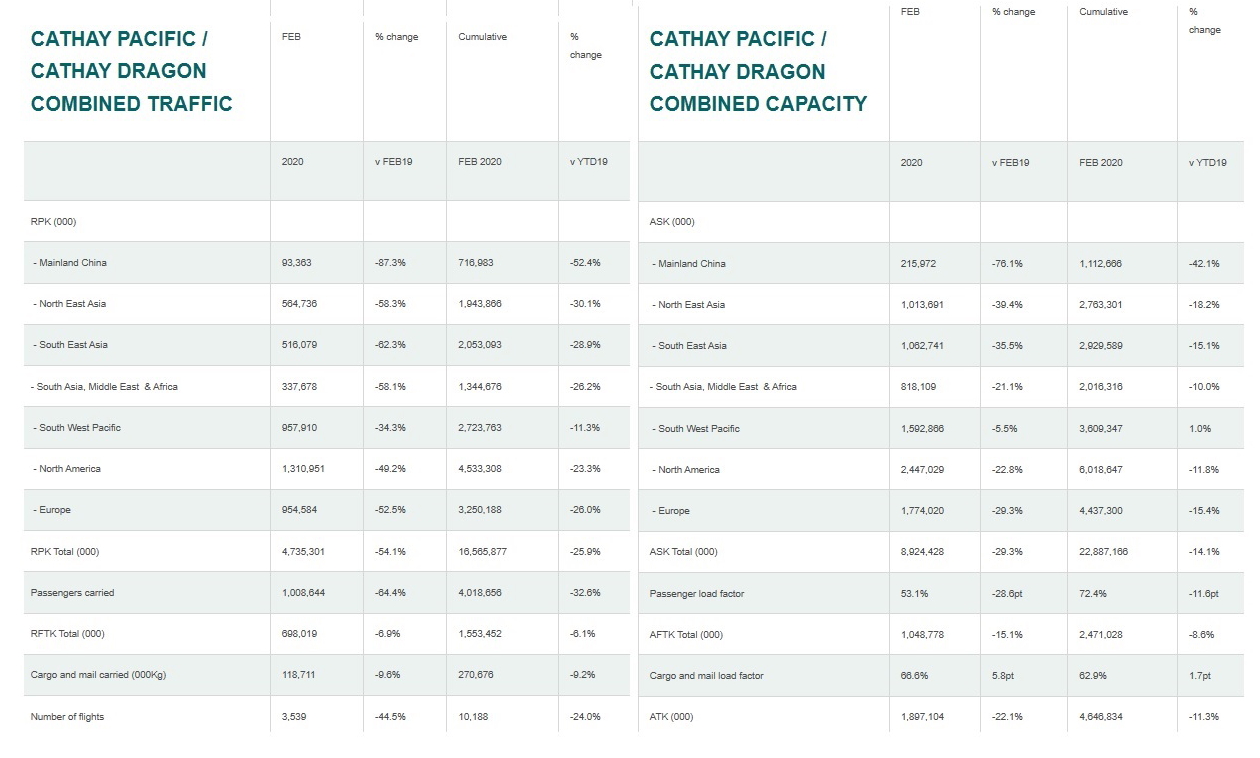|
Cathay Pacific and Cathay Dragon carried a
combined total of 1,008,644 passengers in February 2020, or
4,735,301,000 RPKs (revenue passenger kilometres), a decrease of
54.1% when compared to February 2019.
Passenger load factor decreased by 28.6 percentage
points to 53.1%, while capacity, measured in available seat kilometres (ASKs), decreased by 29.3%.
The two airlines
carried 118,711 tonnes of cargo and mail in February, or
698,019,000 RFTKs (revenue freight tonne kilometres), a decrease
of 6.9% when compared to the same month last year.
The cargo and mail
load factor increased by 5.8 percentage points to 66.6%, while
capacity, measured in available freight tonne kilometres (AFTKs),
was down by 15.1%.

Cathay Pacific Group Chief Customer and
Commercial Officer Ronald Lam said, �We are facing an
unprecedented challenge as the COVID19 pandemic continues to
cause widespread disruption to our operation and business. In
February alone, we made a significant unaudited loss of more than
HK$2 billion at the full-service airline level (Cathay Pacific and
Cathay Dragon). The situation has further deteriorated since
February. We have already announced around 65% passenger flight
capacity reduction for March. Governments around the world have
since introduced more travel restrictions, with the most recent
ones starting to affect our major long-haul markets including
Europe, the United States and Southwest Pacific. Given the
expected further drop in travel demand we are planning to only
operate a bare skeleton passenger flight schedule for April, which
represents up to 90% capacity reduction. If we do not see a
relaxation of travel restrictions in the near future, we expect
the same arrangement will have to continue into May. While our
freighter capacity remains intact, the reduction of our passenger
flights has had a significant impact on our overall cargo capacity
as well as our ability to carry cargo to destinations only served
by our passenger flights. However, we remain flexible in deploying
additional cargo capacity, including mounting additional freighter
flights as well as cargo-only passenger flights.�
Mr. Lam added that, �In February, the first two weeks were poor and the situation
deteriorated even further in the latter half of the month. Our
regional routes, most notably mainland China, Taiwan, Korea and
Philippines, saw the most significant drops in passenger
volume. Overall passenger numbers were down 64% in February
when compared with last year. On a typical day following the
Chinese New Year peak we would normally carry around 90,000
passengers; towards the end of February, that figure dropped to
below 20,000. Our load factors dipped to 53.1% with yield also
significantly impacted.�
Outlook
�The scale of the challenge we are
currently facing is unprecedented and no one can predict when
conditions will improve. Our advance passenger bookings show no
clear signs of recovery at this stage, and the gap in bookings
compared to 2019 continues to widen. We already made it known
last week that a substantial loss in the first half of this year
is expected. Nevertheless, Cathay Pacific is a resilient company
and we remain confident in the future of the company, of Hong Kong
as an aviation hub, and in our ability to thrive in this region
over the long term,� Mr. Lam added.
See latest
Travel News,
Interviews,
Podcasts
and other
news regarding:
Cathay Pacific,
COVID19,
Hong Kong.
|
Headlines: |
|
|
